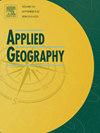Discovering structure and influencing factors of Chinese city directed network (CCDN) from web search engine data
IF 4
2区 地球科学
Q1 GEOGRAPHY
引用次数: 0
Abstract
Numerous studies have addressed city network structures and their influencing factors; however, few have explored the dynamics of directed city networks in the cyberspace. We leverage web search engine big data to analyze structural characteristics of the Chinese City Directed Network (CCDN) and their influencing factors from a cyberspace perspective. The findings are as follows: (1) the CCDN is the mildly disassortative network in cyberspace, the spatial distribution of city interaction follows a "high in the east, low in the west" pattern along the Hu Line; (2) The CCDN contains seven distinct communities, whose boundaries generally correspond with provincial administrative divisions, national city agglomerations, and regional cultural zones; (3) There is a difference between regional and national hub cities, with most hub cities being provincial capitals or prominent tourist cities. In particular, Chengdu surpasses Beijing in both regional and national hubness; (4) Economic growth, investment in science and technology, number of students in secondary vocational schools, and the number of subscribers of internet services are positively correlated with city hubness index, while the proportions of the primary, secondary and tertiary industries are negatively correlated. These factors display significant spatial variability. The results not only suggest novel strategies for city managers to enhance city images and attractivity in the digital era but also contributes new perspectives to the discourse on sustainable city development.
从网络搜索引擎数据中发现中国城市定向网络(CCDN)的结构及其影响因素
大量研究探讨了城市网络结构及其影响因素;然而,很少有人在网络空间中探索定向城市网络的动态。利用网络搜索引擎大数据,从网络空间视角分析中国城市定向网络(CCDN)的结构特征及其影响因素。结果表明:(1)城市网络空间为轻度非分类网络,城市互动的空间分布沿胡线呈“东高西低”的格局;(2) CCDN包含7个不同的社区,其边界一般与省级行政区划、国家级城市群和区域文化区相对应;③区域性中心城市与全国性中心城市存在差异,中心城市多为省会城市或旅游重点城市。尤其值得一提的是,成都在区域和国家枢纽度上都超过了北京;(4)经济增长、科技投入、中职在校生人数、互联网服务用户数量与城市中心度指数呈正相关,而第一、二、三产业比重与城市中心度指数呈负相关。这些因素表现出显著的空间变异性。研究结果不仅为城市管理者在数字时代提升城市形象和吸引力提供了新的策略,而且为城市可持续发展的论述提供了新的视角。
本文章由计算机程序翻译,如有差异,请以英文原文为准。
求助全文
约1分钟内获得全文
求助全文
来源期刊

Applied Geography
GEOGRAPHY-
CiteScore
8.00
自引率
2.00%
发文量
134
期刊介绍:
Applied Geography is a journal devoted to the publication of research which utilizes geographic approaches (human, physical, nature-society and GIScience) to resolve human problems that have a spatial dimension. These problems may be related to the assessment, management and allocation of the world physical and/or human resources. The underlying rationale of the journal is that only through a clear understanding of the relevant societal, physical, and coupled natural-humans systems can we resolve such problems. Papers are invited on any theme involving the application of geographical theory and methodology in the resolution of human problems.
 求助内容:
求助内容: 应助结果提醒方式:
应助结果提醒方式:


